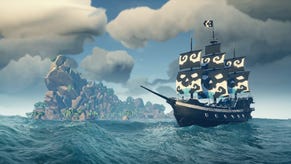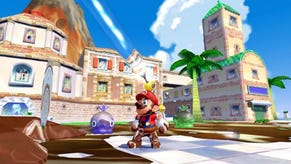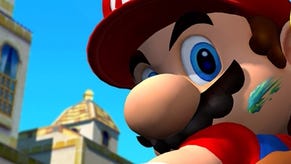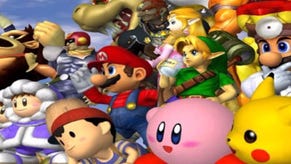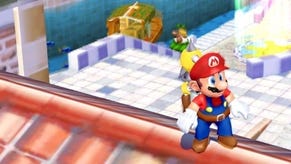Super Mario Sunshine
Review - Mario goes on holiday, and Tom hitches a ride
Mario is an institution. How many videogame characters are recognised ahead of Mickey Mouse? Just one. It's his instant accessibility and the courageously groundbreaking design of his platform games which continues to excite and astound fans of the series.
With Super Mario Bros. 3, Nintendo created an iconic platformer with beautiful design, intelligent pacing and flawless execution. With Super Mario World it did it all again on a new platform employing a completely different structure. With Yoshi's Island, it managed to sideline the character who drives the series and still produce one of the best 2D platformers to date, and with Super Mario 64 it shattered illusions and sold a million N64s. How can Super Mario Sunshine possibly hope to compete?
As it happens, it can do more than hope.
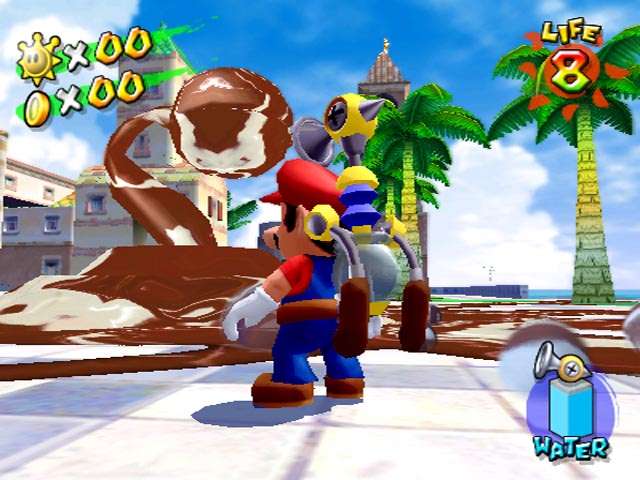
Thief!
Ignoring for the umpteenth time previous conventions, Super Mario Sunshine is set in the aftermath of Mario 64, as our hero and his entourage depart Peach's castle and embark on a much needed vacation to the beautiful tropical island of Delfino. But trouble is afoot as soon as our heroes' feet touch the runway. A silver brush-wielding Mario has emblazoned the entire island with graffiti, and unleashed terrible paint-spewing monsters to transform the delicate setting further. This will not stand, of course, but before Mario can do anything about it of his own accord, he's thrown into jail, accused of performing the heinous act himself, and sentenced to clean the entire island. The only way to prove his innocence is, ironically, to carry out his sentence, and to try and figure out along the way just who or what is responsible.
To aid the cleanup operation, Professor E. Gadd, who you may well remember as the mad gadget-building scientist in Luigi's Mansion, has equipped Mario with a water gun backpack, which can be used to fire water in a stream ahead of the plumber, or be shot down underneath him like a jet pack. The two modes are toggled by X, and the pressure-sensitive right trigger is used to control water flow. As with Mario 64, the left thumbstick controls Mario's movement, from a tiptoe through to full pelt, and in Sunshine it's also used to direct the water cannon. When the R button is fully depressed, Mario stops still and the thumbstick allows him to direct the water precisely. The water pressure runs out after a short while, although the water store is quite expansive - however, a quick trip to a drinking trough, lake or even the ocean and a tug on the R button refills and rejuices.
Other than that, the controls are very much the same as Super Mario 64. Mario can perform the same three-stage jump he could in Mario 64, he can perform a backflip jump - useful for reaching high platforms in confined spaces - by running one way then quickly snapping the stick back and jumping the other, and he can pound the ground by jumping and then pressing the L trigger. Furthermore, he can slide around like a demented penguin on ice, and he can also scale heights by jumping from wall to wall - very Crouching Tiger.

Shine on
Of course, the control system is about as perfect as we could have hoped. Mario's adventures still involve performing otherworldly tasks in peculiar settings to collect stars (or "shines" in this case), and control of him is very simple and easily picked up. Even the addition of the water backpack doesn't cause any difficulties - you'll quickly get the hang of switching between modes, hovering over gaps and using the jetpack mode to reach areas you didn't think possible. You even develop clever little shortcut moves, like performing a backflip jump and then using the jetpack to climb a few extra feet onto a bit of netting in the harbour level, or performing a three-step jump to get maximum distance and then jetpacking the rest of the way across a ravine. It's all very intuitive and you'll fall in love with the changes as if they'd been there since the very first Mario titles.
Sadly though, Super Mario Sunshine's one major failing is in the control department, specifically the camera. The camera in Super Mario 64 was almost perfect - the several step technique with the yellow "camera buttons" as they became known wasn't quite perfect, but it was very close. Sunshine's camera gives you more freedom, allowing complete rotation via the C-stick, but it never quite gels. The camera always needs minute adjusting, and so you feel like you're playing with two thumbsticks and not one - and juggling face button moves like jumping and backpack modes whilst keeping the camera in check can be maddening, and leads to failure more than enough times throughout the game. The camera also has a tendency to clip into scenery here and there, and all in all feels a bit too messy and unreliable. Not something we're used to in Mario releases.
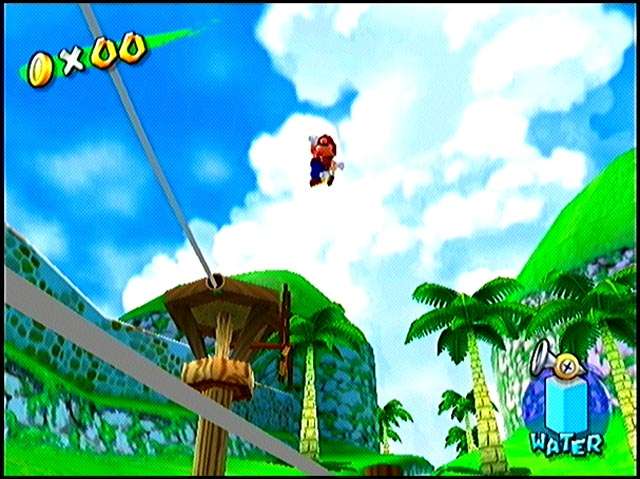
Design is law
Fortunately, Shigeru Miyamoto's minions haven't failed to produce a lengthy, compelling single player adventure. Some felt that Mario 64 was simply too easy, but Sunshine is paced somewhat peculiarly to give you challenge whilst always offering something simpler. The level hub this time around is the capital of Isle Delfino, which sits in the shadow of a volcano with a huge sunshine gong in an arch towering over the town and providing light. Countless buildings are dotted around, as well as an inlet for ships - including a boat which will take you out to the furthest islands if you hang around - and throughout the town lurk a variety of plump Delfino residents, some of whom will bat you about the ear for polluting paradise, and some of whom will help you or even challenge you, which can lead to your winning various bonus shines.
Levels are not simply hidden in houses and behind portraits though - Mario has to first collect enough shines that his nefarious counterpart will expose himself and open up another level. The first few times, levels are opened as M-shaped portals on statues and buildings. Mario finds a big splotch of paint, defeats a painted plant mini-boss and then unlocks the portal, allowing him to visit various areas of Isle Delfino and continue the cleanup operation. After a while though, level portals vary from sneakily hidden green tubes to human cannons and even peculiar sunbeams.
Level design is typically Miyamoto. Unlike Mario 64, objectives on a given level have to be completed in a certain order - although you can tackle levels in any order once you've unlocked a few - and levels literally morph into different versions of themselves with each shine you collect. For example, journey to the top of the windmill on the first level and usurp a petulant paint-spitting plant and you'll come back to find the entire lake splattered in paint, and have to use lilies as makeshift rafts in order to get to coins and other platforms.
Naturally, there's a great deal more to Mario Sunshine than beating bosses, bopping enemies on the head and cleaning paint. The sheer variety in level design and objectives will keep you coming back for more even if you think you're bored. Complete a series of objectives which goes something like boss encounter, elastic band puzzle, flying plant encounter, metal lattice climbing, octopus-taming and fruit juggling, and you'll find even more variety in the backpack-less levels. Mario's nemesis, whose identity is borne out in an explosive rollercoaster ride (no exaggeration) of a boss encounter after a couple of hours, occasionally steals Mario's pack and leaves our hero to fend off obscenely difficult old-school 3D platform levels. These gradually get harder and harder, with moving platforms, spinning blocks to climb and hugely tricky, pixel-perfect jumps to perform, and after a while they go completely mad, taking place in a Pachinko table, on the back of a flying sand-block bird and worse. You'll run through lives like confetti as you battle to beat them, but you always seem to have accrued just the right number to beat them...
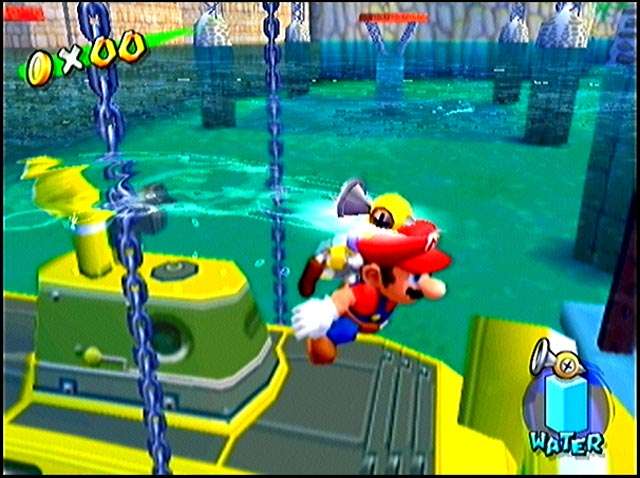
It's a-me!
The two things we haven't bothered to go into yet are Mario's graphics and sound. Of course the gameplay is the defining aspect of the game, and we've been happy to let you imagine the game in a Mario 64-style setting because, whether you're happy about it or not, that's what we have here. The graphics are post-Mario 64 but only by a short distance. At its heart, apart from increased resolution and a bit more texture and character detail, the game looks ostensibly the same, but it's the fine details which keep the game fresh and exciting, and the way Nintendo's artists have chosen to wield the Cube's power.
The first thing you'll realise is that it runs at a smooth 60 frames per second, and that the draw distances are absolutely huge. Levels are enormous, and unlike the N64, the Cube can handle almost the entire vista on screen at any given time, with islands in the background, countless enemies patrolling the screen and palm fronds, frothing water and shiny reflective platforms. The water effects throughout the game are certainly stunning - from the way it flows and trickles as commanded from Mario's backpack to the way it laps up on the beaches and parts in waves as Mario wades or splashes into it, and the softness of the reflections - it's a real eye-opener.
Elsewhere, character and enemy animation reaches a new high. Mario, the Princess, Toad, Yoshi and others all look incredibly cute as they move, and Mario's shiny nemesis is like something out of Terminator 2. Mario's movement is perhaps the best though - tiptoeing is exaggerated like a cartoon, whilst walking is energetic, chest puffed out, and running full pelt sees limbs flailing and the tippy-tap-tapping of his tiny shoes on pavement, grass and wood. Like every aspect of Mario Sunshine, the graphics and sound effects are familiar, yet captivatingly fresh. And the soundtrack is typical Nintendo - mixing old tunes and new to create a tropical crescendo - and backs every level with almost unfettered success.
A plumb
Mario is a long game, too, and that's important. Mario 64 was only criticized for being too easy for all its efforts, and Luigi's Mansion, not to mention Miyamoto's comments on the subject all seemed to point to shorter games, more often. Fortunately, Sunshine is a lot longer. There are 120 shines to collect, and a stupid number of blue coins, which also make a difference to the end sequence. To fetch them all is probably going to take the best part of 20-30 hours, and that's if you don't spend hours exploring the intricacies of the various levels. We wouldn't like to say how many hours we've clocked, but it's more time than we've spent playing the rest of the games which live in Mario's pile on the top of the TV. Hey ho.
To say that there has been an air of expectancy surrounding Super Mario Sunshine is like saying that plumbers don't wear ties. It seems almost pointless to draw attention to something so glaringly obvious. This is the sequel to Super Mario 64, the game which launched a platform and reminded the world that Shigeru Miyamoto makes the best platform games. Super Mario Sunshine couldn't hope to shatter boundaries and reshape the genre for a second time, but it could and has managed to provide one of the biggest and most entertaining platform games since its illustrious predecessor. The best game ever? No, but you'd be a fool not to buy it.

